古唐津に迫る(矢野直人)
Zeroing in on Ko-karatsu, Surpassing Ko-karatsu(Naoto Yano)

桃山時代から江戸初期に掛けて焼かれていた「古唐津」。そのぐい呑は、酒徒垂涎の一客と言われており、伝世の品ともなれば、現在でも数十万から数百万円という高値で取引きされています。古唐津は、江戸初期に磁器である古伊万里が登場するとすぐに衰退してしまい、わずかな期間しか作られていないことから謎の分部が多く、近代以降、多くの陶芸家がその謎の解明、その再現に人生を掛けてきました。
そのような状況の中、ここ数年、古唐津に関する新たな説が浮上し、にわかに注目を集めています。それは「古唐津は陶器ではなく磁器であった」というものです。これまで多くの陶芸家が古唐津の窯跡近くの粘土を使用し、その再現を試みてきましたが、残念ながらその再現に完全に成功したとは言えません。古唐津や古伊万里は、当時、既に磁器を焼成する技術を有していた朝鮮の影響を色濃く受けていたと考えられています。その技術を用い、日本でも同じ磁器を焼成しようと試みたところ、原料となる磁石が見つからなかったため、砂岩(さがん)と呼ばれる別の石で古唐津が焼かれ、江戸初期に有田で泉山の磁石場が見つかった後は、砂岩が使われなくなり、自然と古唐津が衰退したという考え方です。唐津が陶器ではなく磁器であったとは、これまでの前提を大きく覆す説ですが、実際にこの砂岩を使用して作陶を試みたところ、これまで以上に古唐津に近い器を焼成することができ、この説が唐津の陶芸家の間で注目を集めるようになったのです。
現在、砂岩を使用している有名な陶芸家として、梶原靖元さん、矢野直人さんがいますが、今回、矢野直人さんにご協力いただき、砂岩を使用した唐津焼の作り方について、取材をさせていただきました。
Ko-karatsu (Old Karatsu) – the ceramic produced from Momoyama era (1573~1603) to early Edo era (1603~). Ko-karatsu sake cups have been considered as the envy of many sake connoisseurs, and the ones that passed down for generations are traded up to several million yen now. Ko-karatsu went into decline very soon after the porcelain of Ko-imari(Old Imari) emerged in early Edo era. Because of such a short life, it involves a great deal of mystery, and many modern ceramic artists have devoted their artistic lives attempting to reproduce this enticing style of art.
In this circumstance, a new theory on Ko-karatsu has emerged in recent years and quickly attracted attention. It suggests, “Ko-karatsu was actually not pottery but porcelain.” While so many ceramic artists have tried to reproduce Kokaratsu with the clay found near its kiln ruins, none, unfortunately, has really succeeded.
It is considered that Karatsu and Koimari are influenced by ancient Korea that had developed porcelain-making technique back then. When artisans tried to produce the same porcelain in Japan by Korean technique, they could not find kaolin and used different stone called sandstone to produce Karatsu. In early Edo era, kaolin mine at Izumi Mountain, Arita was discovered and the use of sandstone was discontinued, thus Karatsu naturally went extinct.
Classifying Karatsu as porcelain but not pottery, this theory completely reverses the common belief. Yet, some actually tried to use sandstone and successfully created the pieces that were much closer to Ko-karatsu than any works produced before. This is why this theory is getting serious attention among Karatsu ceramic artists. Today, Yasumoto Kajihara and Naoto Yano are the famous ceramic artists using sandstone. Thanks to generous cooperation of Mr. Naoto Yano at this time, we look into the details of Karatsu creation using sandstone.
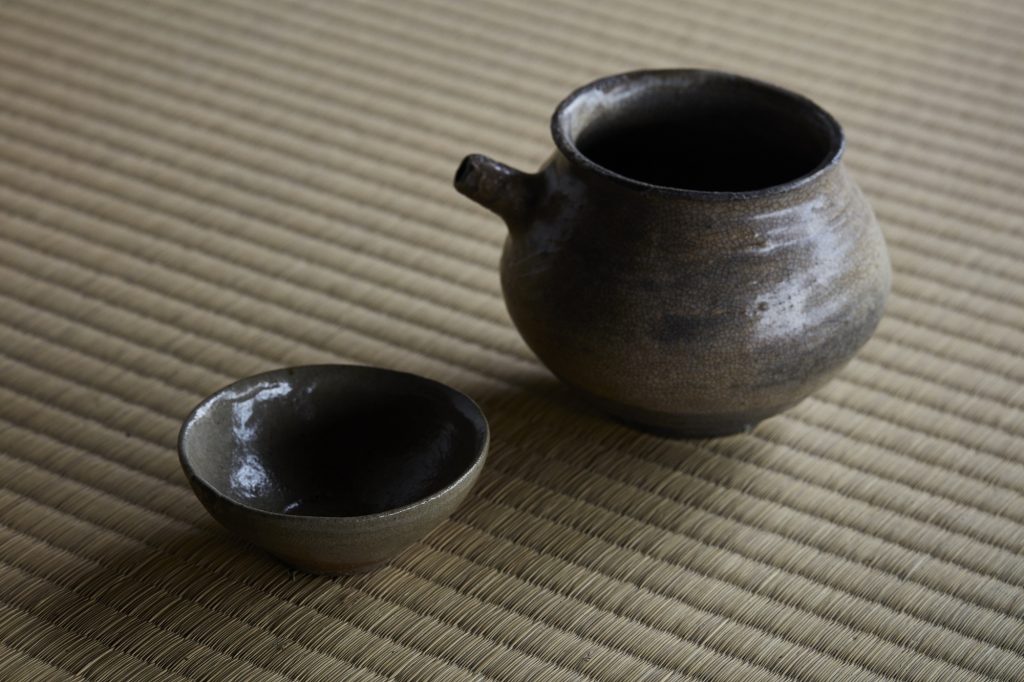
矢野さんのお客様が使われていたという無地唐津の盃(左)と刷毛目の片口(右)です。既に古格を感じさせ、無地唐津は古唐津を、刷毛目は李朝のものを彷彿とさせる雰囲気ですが、どちらも矢野さんが砂岩を使用して作られた作品です。
Muji Karatsu (Karatsu ware with no painting) sake cup (left) and Hakeme (brush stroke) katakuchi (single-spouted) sake server (right) that a customer of Mr. Yano has been using. Wearing the aged ambience, Muji Karatsu and Hakeme resembles Kokaratsu and Yi Dynasty pieces, but both were the sandstone creation by Mr. Yano.
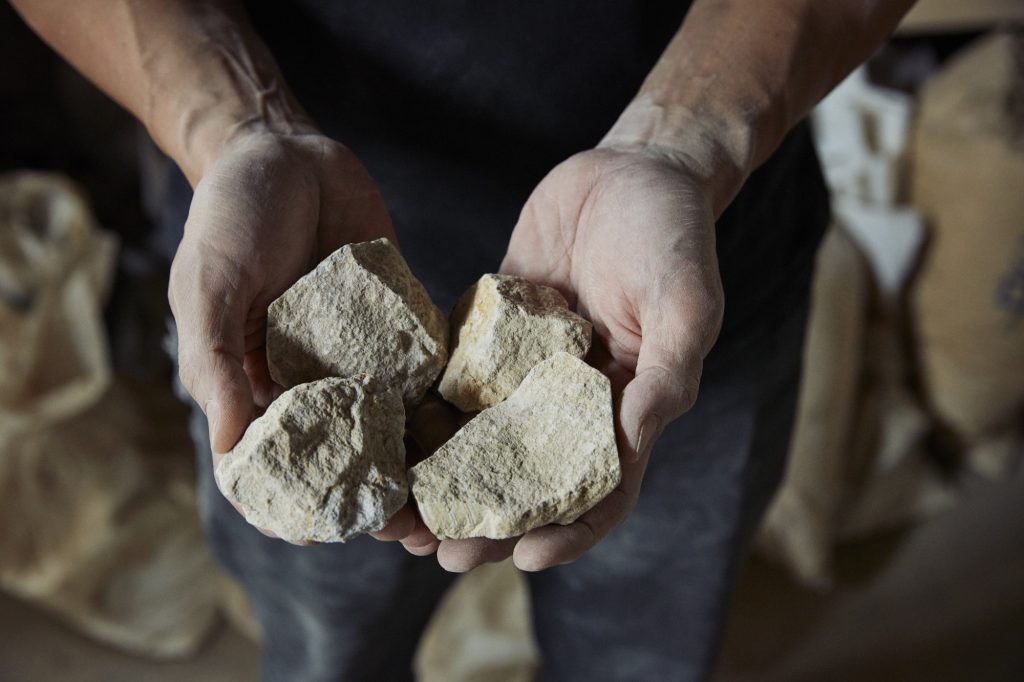
原料となる砂岩。佐賀県内の唐津や有田の土地で矢野さん自らこの砂岩を採取しています。砂岩を砕き、粘土を作るところから矢野さんの唐津焼は始まります。
The main ingredient – sandstone. Mr. Yano himself collects them in field of Karatsu and Arita of Saga Prefecture. His Karatsu creation starts at smashing sandstone and making clay.
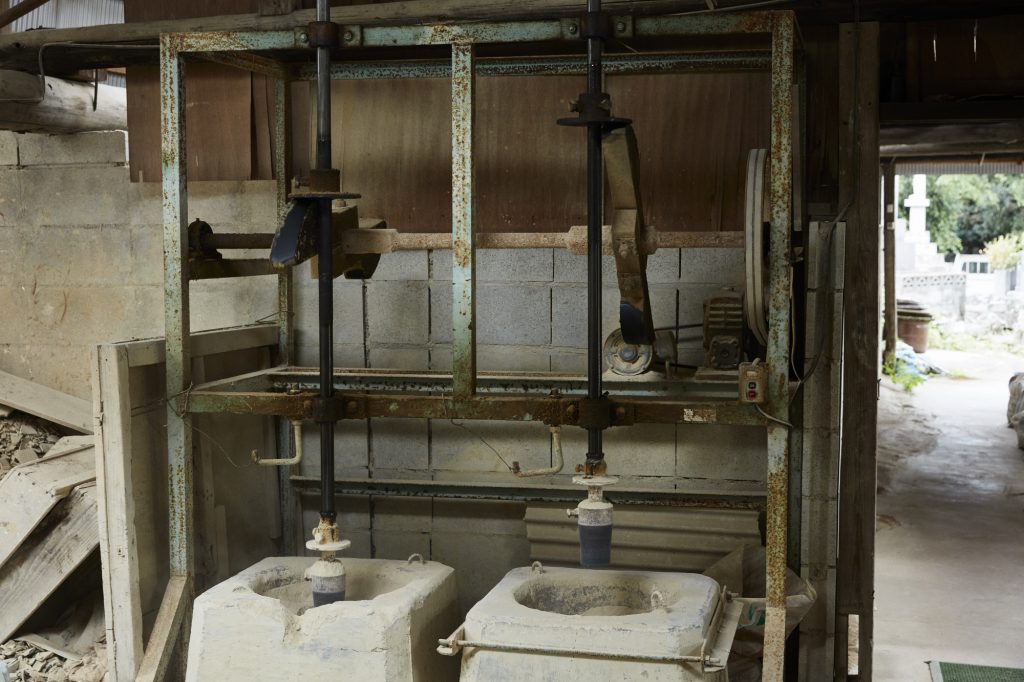
スタンパーで砂岩を砕き、砂状にしていきます。偏りが出ないように1時間に1回掻き混ぜながら細かく砕いていきます。スタンパーが動く度にガチャン、ガチャンと大きな音が作業場に響き渡ります。
Smashing sandstone by a stamper to the grainy state. Stirred every hour to avoid the uneven crush, the stone is milled to fine grains. Large clashing sound echoes inside the studio at every move of the stamper.
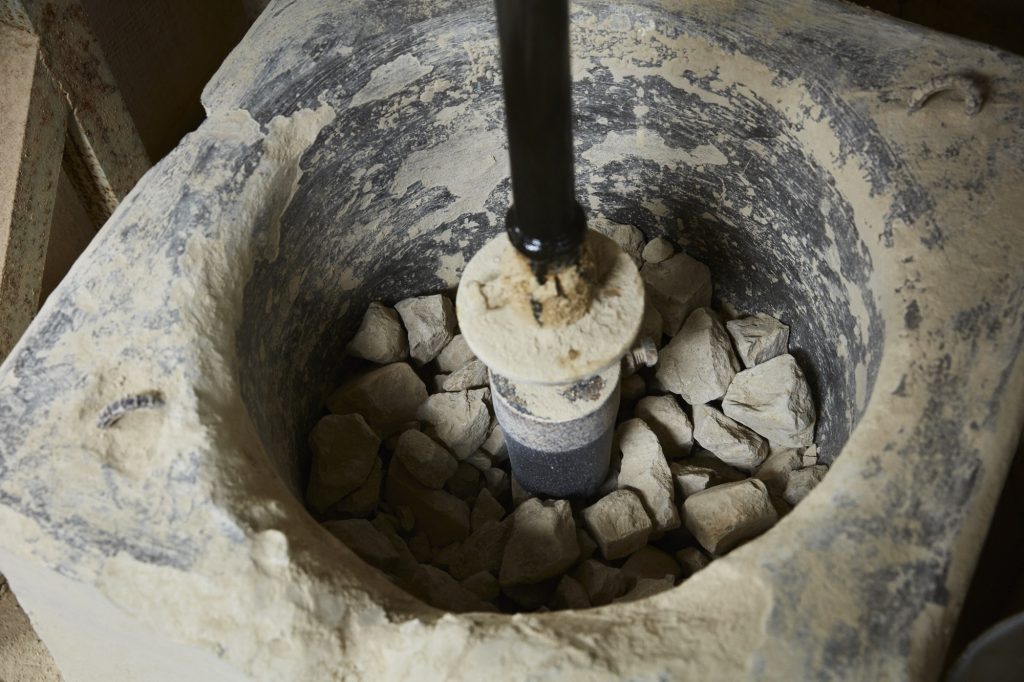
今、スタンパーで砕いているのは、有田の平戸系の砂岩。古唐津の中でも絵唐津が焼かれていた地域のものです。
The stamper is working on the sandstone from Hirado area of Arita now. It is where the Egaratsu (painted Karatsu) category of Kokaratsu was made.
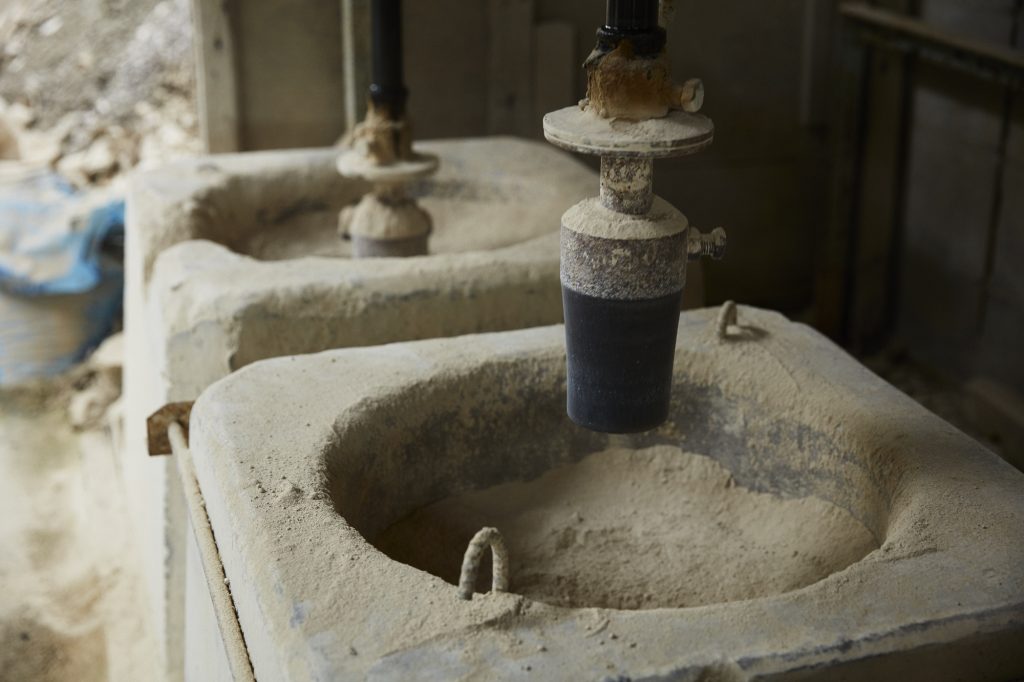
スタンパーで砕き始めて12~13時間経った状態。砂状になっているのがよく分かります。これをザルで漉した後、矢野さんが最も重要だと語る水簸(すいひ)の作業に移ります。
How the stone looks after about 12-13 hours in the stamper. You can clearly see that all has turned sandy grains. After straining with a sieve, Mr. Yano starts what he considered as the most important work – hydraulic elutriation.
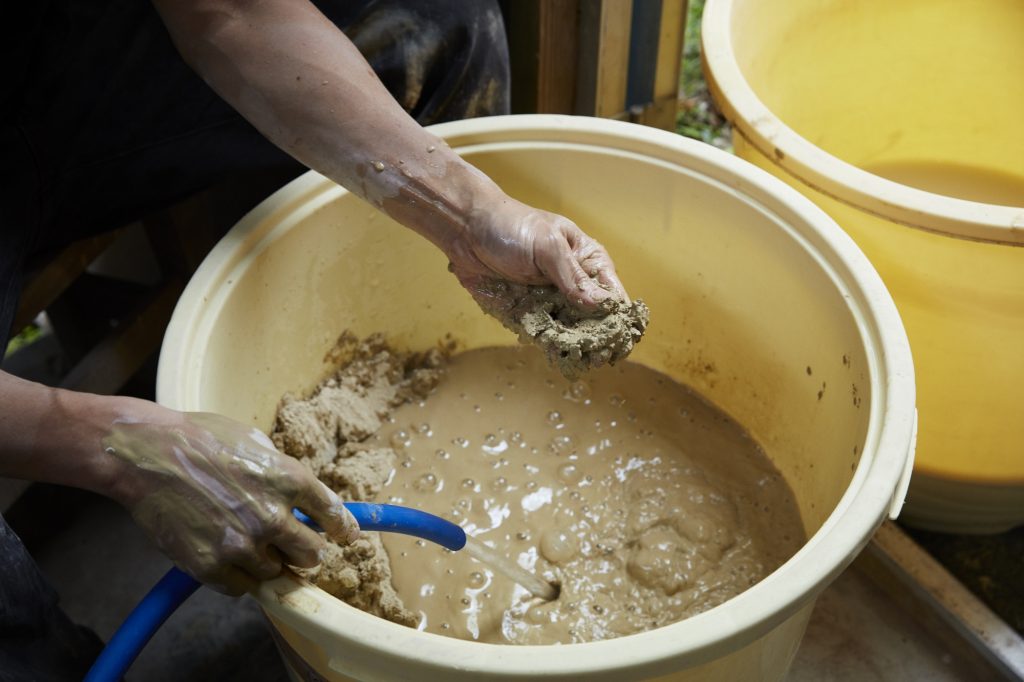
砂状になった砂岩をバケツに移し、水を注ぎます。これを撹拌すると、重い石などの不純物や鉄分はすぐに沈むため、上澄みの部分だけを掬って隣のバケツへ移します。移したバケツの底に沈殿したものが、作陶に使われる粘土となります。
He moves the sandstone-turned-grains to a bucket, and pours water. When stirred, the impurity like heavy stone particles and iron sink rapidly. He scoops out supernatant to the next bucket. The deposit at the bottom of that bucket is the clay to make ceramics.
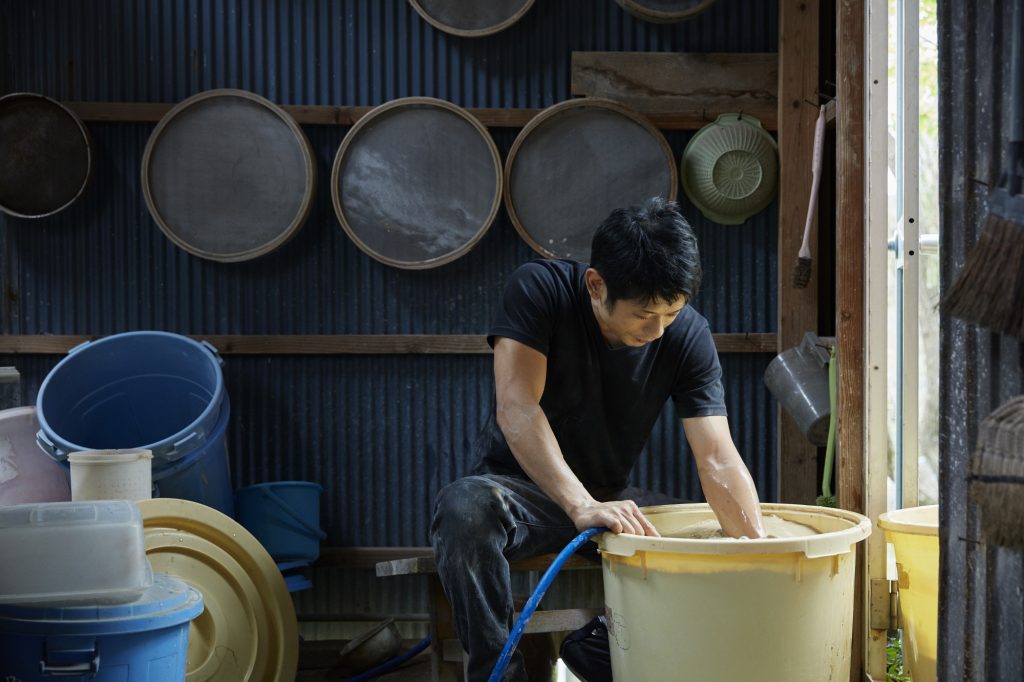
土づくりをする上で、この水簸の工程が最も重要だと矢野さんは言います。実は白磁を焼くための土づくりも、原料が砂岩から磁石に代わるのみで、これと全く同じ工程を行うそうです。
Mr. Yano claims that this hydraulic elutriation is the most important process for clay-making. The ingredient for white porcelain is made by the identical procedure, only with a different ingredient of kaolin instead of sandstone.
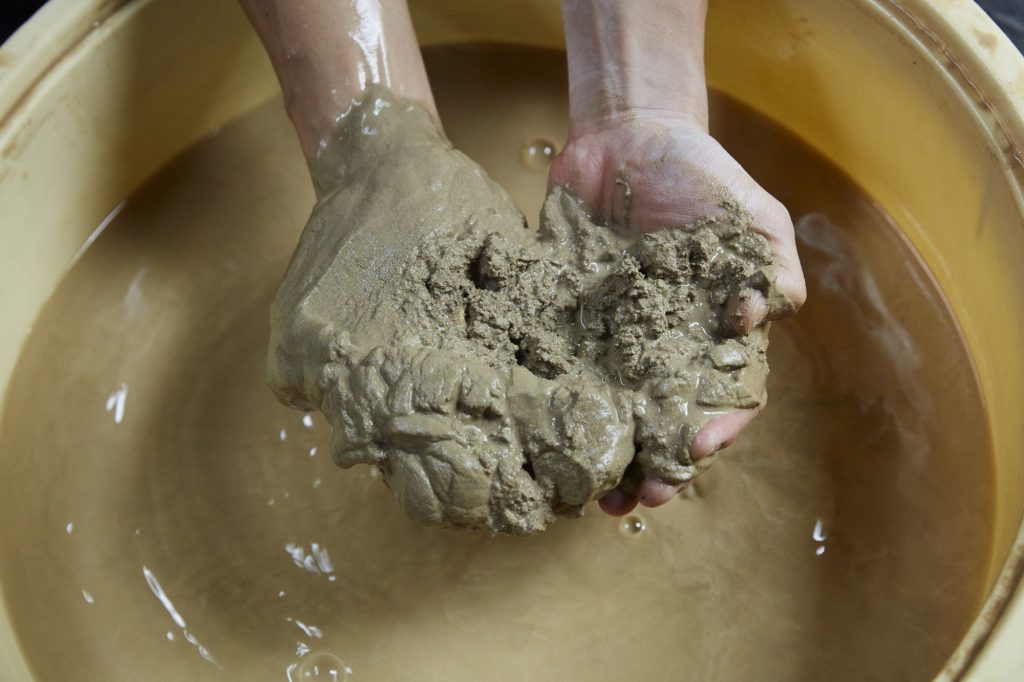
これは最初のバケツに沈殿したもの。一見、粘土のように見えますが、不純物や鉄分が多く、焼物を作るのには適しません。しかし、これらをできあがった粘土に1割ほど混ぜると、轆轤での成型がしやすくなるそうです。
This is the deposit in the first bucket. While it looks like clay at a quick glance, it contains too much impurity and iron to make ceramics. However, it helps shaping on a potter’s wheel when mixed in the final clay at around 10%.
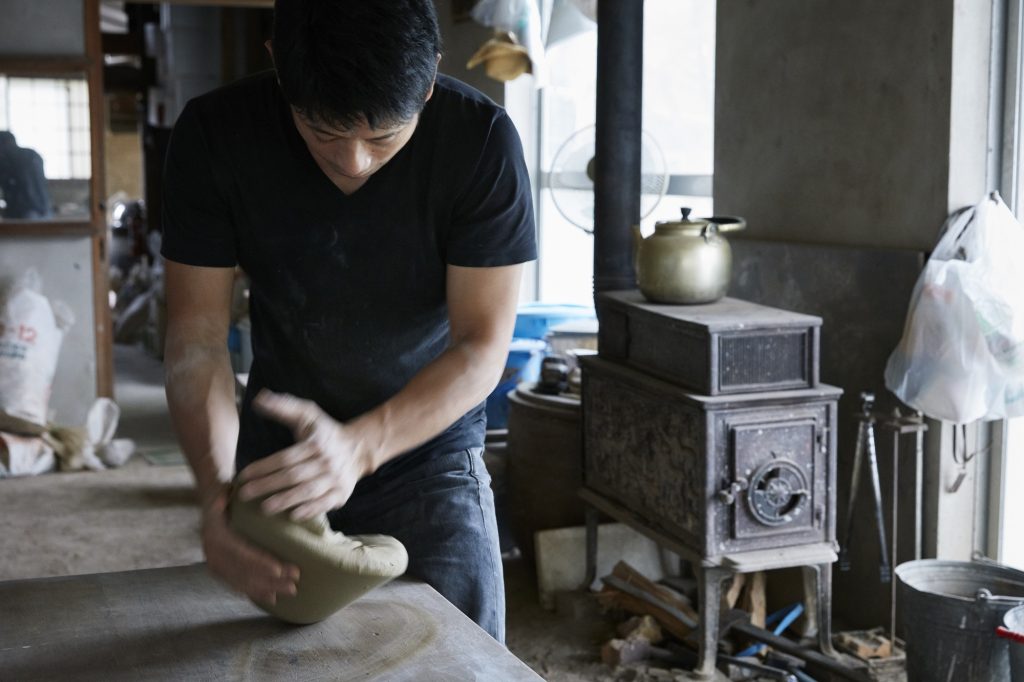
矢野さんが砂岩を使って唐津焼を作るようになってから約10年が経ちますが、最初の2、3年は、このような土捏ねもまともにできず、土作りには大変苦労されたそうです。
It has been around 10 years since Mr. Yano started his Karatsu creation with sandstone. In his first few years, he suffered a lot with formulating the right clay, and could not even reach to the clay-kneading stage like this.
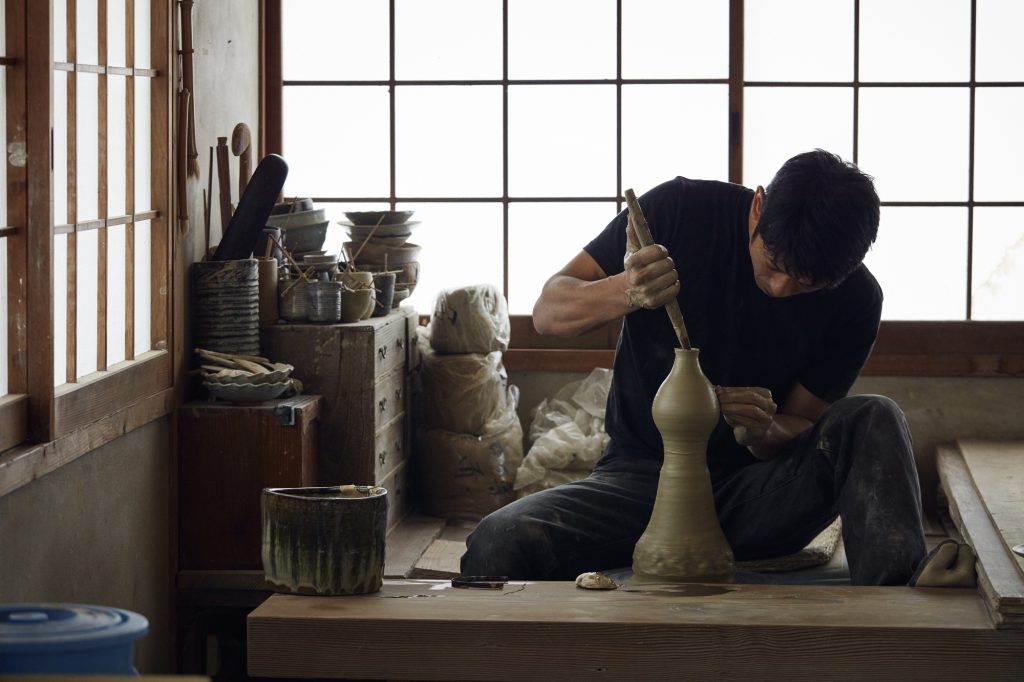
粘土が完成し、轆轤成型です。矢野さんは、成形するときは電動轆轤を使用し、高台を削るときは、蹴轆轤を使われています。
Once the clay is ready, he moves on to the shaping stage on the potter’s wheel. Mr. Yano uses the electric wheel to shape, and the kick wheel to shave out the kodai (foot).
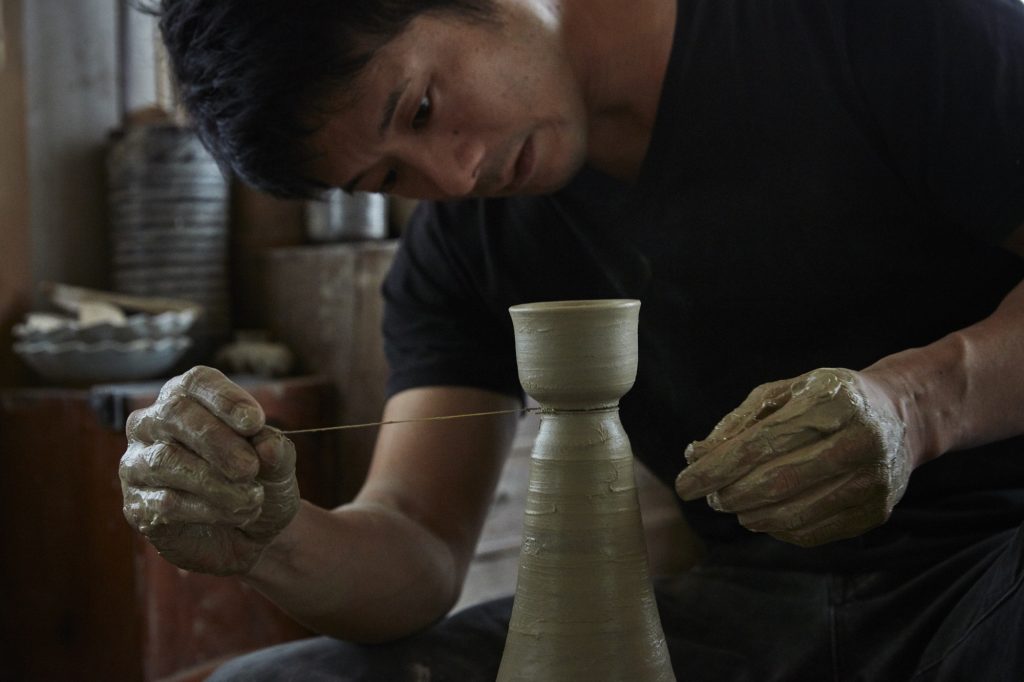
瞬く間に次から次へと器が成型されていきます。途中、冗談で「喜左衛門(国宝の井戸茶碗)でも引きましょうか?」と言いましたが、何と一度見た有名な茶碗は、どのように轆轤が引かれ、どのように高台を削っているか、すべて鮮明に覚えているとのこと。これには驚きました。
He quickly shapes one piece after another. Along the way, he jokingly offered to “shape a Kizaemon (the national treasure Ido tea bowl from the ancient Korea).” He explains that he can clearly visualize and remember how all famous tea bowls he has seen were shaped on the potter’s wheel and how their kodai were shaved after a single encounter. I was amazed to learn this level of expertise.

サンプルで轆轤を引いていただいた作品。釉掛けも焼成もする前の状態ですが、どれもとても美しい佇まいで、つい見入ってしまいます。
Sample pieces shaped on the potter’s wheel. Despite the pre-glazing/pre-firing state, all are so purely beautiful that I cannot take my eyes off.
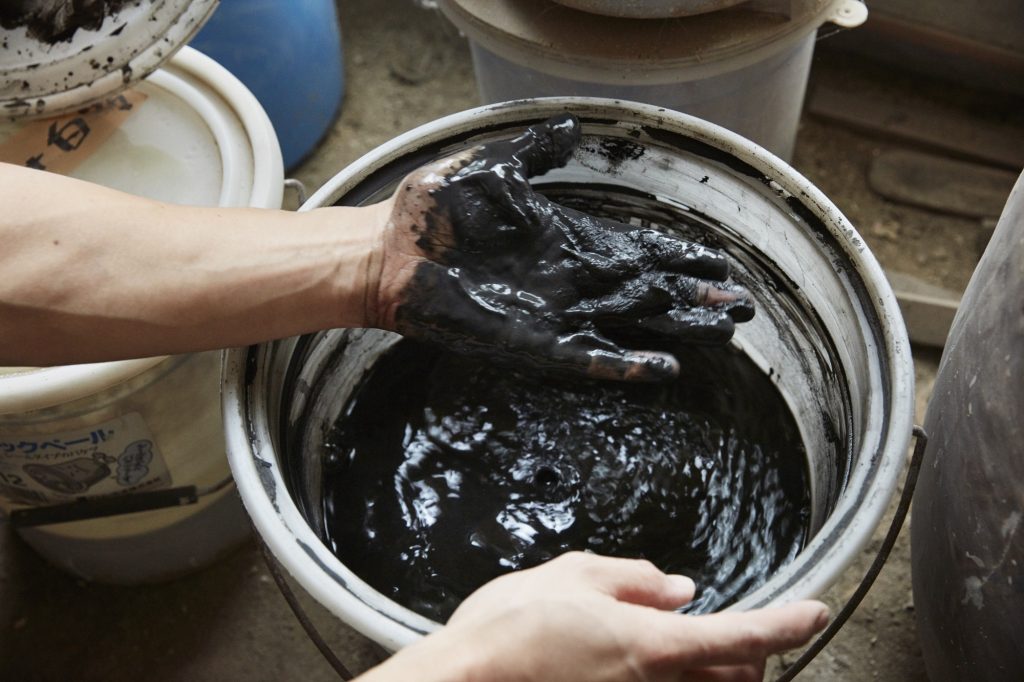
矢野さんが使われている釉薬のひとつ。見た目は真っ黒い釉薬ですが、これが斑唐津の釉薬です。灰の炭素成分によって黒くなっていますが、焼成するとこれがあの美しい斑模様へと変化します。
One of the glazes Mr. Yano uses. Black as pitch at a glance, it is a Madara Garatsu (dappled Karatsu) glaze. Its color comes from carbon in ash, which creates the beautiful dappled speckles when fired.

この赤い釉薬は、朝鮮唐津に使われる飴釉です。鉄分が多いため、赤い色合いをしていますが、焼成されると朝鮮唐津のあの飴色や黒色に変化します。矢野さんは、この他にも常時10種類ほどの釉薬を使われています。
This red one is caramel-colored glaze used for Chosen Karatsu. Containing a large amount of iron, the liquid is in red but gives out the characteristic caramel color or black of Chosen Karatsu. Mr. Yano constantly uses 10 other different glazes on top of what I saw so far.
成形、釉掛けが終わるといよいよ窯焚きです。矢野さんは、割竹式登り窯という窯を使用していますが、その窯焚きの様子を後日取材させていただきました。
After shaping and glazing stages, the art pieces finally go into the kiln and fire. Mr. Yano uses a style of kiln called waritakeshiki (sectioned bamboo), we had an interview for firing on another day.
取材日:2016年10月10日
カメラマン:関口史彦
Date of Interview/Photo: October 10, 2016 (up to shaping)
Photographer: Fumihiko Sekiguchi
本写真の無断での使用、転載を禁じます。




